Impact of an Intensive Primary Care Service on Health Services Utilization in a High-Utilizer Patient Population [Health care services, delivery, and financing]
Annals of Family Medicine
NOVEMBER 20, 2024
Context: High-utilizer patient populations reflect poor health for those patients and high resource use for health systems. Few studies of high-utilization patient programs found improvements in the intervention groups compared to controls. Setting: Safety net hospital/clinic system in Fort Worth, Texas. 25% decrease], p=.02),












Let's personalize your content